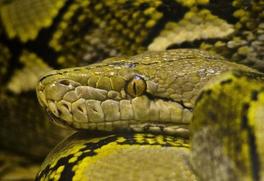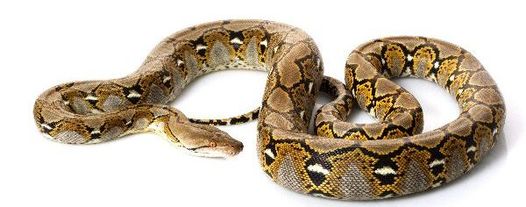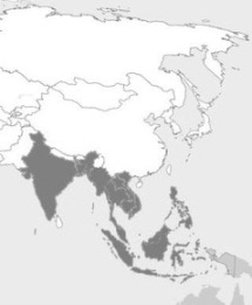Reticulated PythonMalayopython reticulatus |

Custom Search
|
Reticulated pythons are found in tropical rainforests, woodlands and nearby grasslands, usually near water sources like rivers, streams, and lakes.
Like other large python species such as the burmese python, escaped reticulated pythons are found on a regular basis in Florida. Even though they probably aren't yet breeding in Florida, they have the potential to become another of Florida's invasive snakes. Their large size as full grown adult snakes makes them slow and heavily dependent on water for moving. They are excellent swimmers, sometimes reported far out at sea, the species was able to colonize many small islands within its range. The reticulated python can reach lengths of more than 20 ft (6 m) but normally grow to an average length around 10 to 20 feet. They can weight up to 350 pounds (158 Kg) but most individuals weigh much less than that. They have a very complex color pattern with a geometric design including diamond shapes and other smaller markings and many colors like tan, brown, black, olive green, white and golden yellow. This pattern is called disruptive coloration and allows them to blend into their surroundings and remain virtually undetected, both to predators and prey.

Because of the species wide geographic range, there's a great deal of variation in color, size, and markings.
The species-specific name "reticulatus" is the Latin word meaning "net-like", or reticulated, and refers to their complex but also very beautiful color pattern. The reticulated pythons are quite capable of defending themselves and will not hesitate to strike after curling into an "S" shape. They may live 20 years or more in captivity and in the wild around 15 to 20 years. Subspecies / Taxonomy In recent years there have been a number changes concerning the scientific name of this species until 2014 it was formerly known as Python reticulatus. Since their color and size can vary a greatly among individuals and geographic location, several species or subspecies have been proposed, but most have yet to find general acceptance. For now, there are 2 other subspecies currently recognized found on islands south of Sulawesi Selayer reticulated python (M. r. saputraiand) - Found on Selayar Island. Kayaudi dwarf reticulated python (M. r. jampeanus) - Found on Tanahjampea or Jampea Island in the Selayar Archipelago. Recent phylogenetic studies suggest that reticulated pythons and the Timor python are close relatives of Australasian pythons more so than those found in Africa like the African rock python. Danger to humans
Most reports of attacks on humans are unsubstantiated. But they are considered capable of killing and maybe eat humans and have been responsible for human fatalities, in both the wild and in captivity. Diet / Feeding The reticulated python is carnivorous and feeds mainly on small o medium mammals but occasionally also birds. The smaller snakes hunt mainly small mammals like rats, while larger specimens can also take larger animals like pigs, civets, bearcats, monkeys or small deer. However, they have been documented killing some amazing creatures like tigers, panthers or crocodiles. Reticulated pythons are sometimes found near human dwellings, and are known to have eaten goats, chickens, cats or dogs. These non-venomous snakes are ambush predators by nature, waiting in hiding for prey to come close by, before striking and grabbing it in the coils, and killing it by constriction. They will seldom actively seek prey because of the energy cost associated with this. These large snakes are able to swallow big prey items probably close to their own weight and up to 1/4 their length. When attacking their prey they grab it using their backward-curving teeth, and coil their powerful muscular body around it, squeezing until the victim dies. Then the reticulated python swallows their food whole. They can dislocate their jaws allowing them to open their mouths very wide enabling them to consume large prey items. Often it takes them a very long time to digest a meal so they usually only eat every few weeks and can go for long periods of time without feeding. Reproduction This species reaches sexual maturity at about 2 to 4 years, with females measuring about 11 ft and males around 7 to 9 feet long. The breeding season occurs between September and March as the temperatures begin to drop. These snakes are oviparous, the female lays anywhere from 15 to 80 eggs per clutch which hatch after a period of approximately 85-90 days. The eggs are whitish in color with a soft and leathery shell. Just like a female bird incubates her eggs by sitting on them, female pythons wrap their bodies around their eggs and shiver in a behavior known as brooding. This prevents the eggs from getting too warm or too cool as they need to remain at temperatures around 88°- 90ª F (31° - 32ª C) during the incubation period. The hatchlings measure around 2 ft (61 cm) at birth and get out of their eggs by cutting a slit in the eggshell with an egg tooth. Conservation / Threats Although the reticulated python is still widespread throughout most of its range their numbers are dwindling. There are several reasons for that like the widespread killing for the illegal skin trade and some fall victims to the Asian rituals of blood drinking or gall bladder removal. From 2000 to 2007 Indonesia and Malaysia exported more than 2,5 million wild pythons, just for the fashion industry. The reticulated python is farmed for their skin and meat which is considered a delicacy in some places, there are more than 5000 of these farms throughout South East Asia. When encountered in the wild by humans these snakes are almost always killed. The species isn't evaluated by the IUCN and is listed on Appendix II of CITES.
|
Scientific classification |
© 2014 Snake Facts About Us | Privacy Policy | Contact




